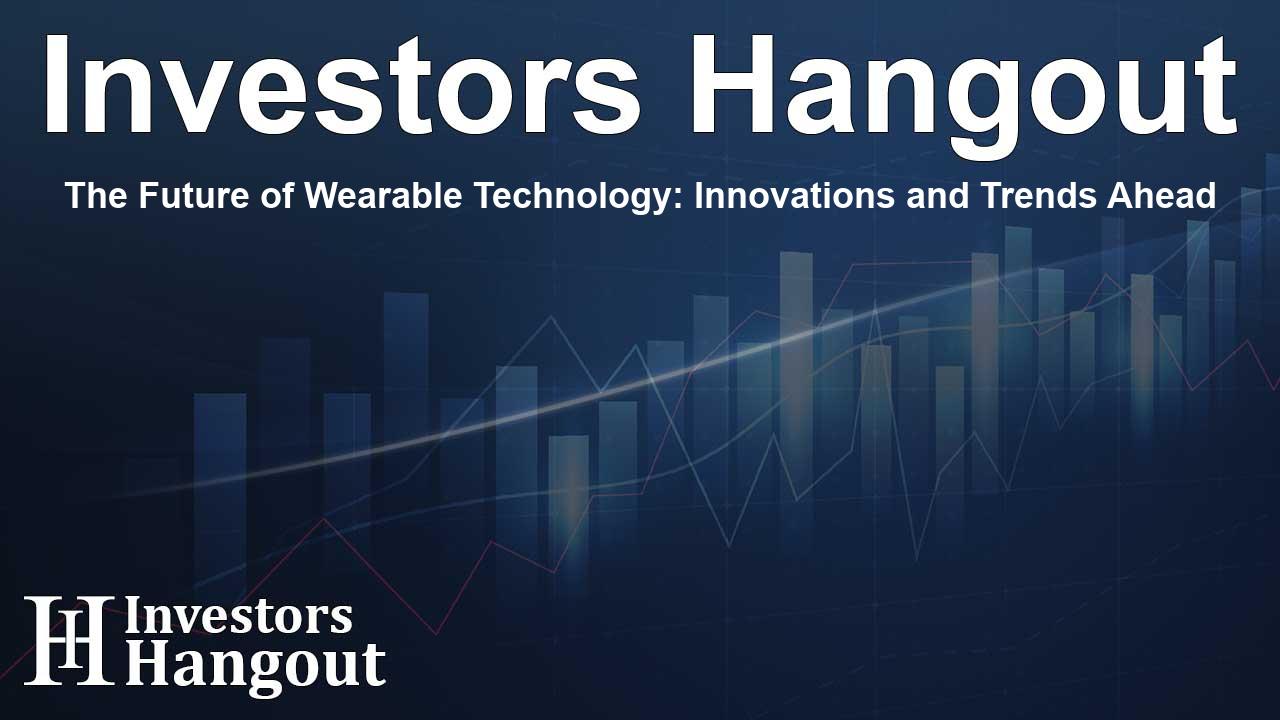The Future of Wearable Technology: Innovations and Trends Ahead

Wearable Technology Market Anticipates Remarkable Growth
The global wearable technology market is poised for explosive growth, with projections indicating a valuation of US$ 885.65 billion by 2033, a substantial increase from US$ 218.27 billion in 2024. This impressive rise represents a compound annual growth rate (CAGR) of 16.84% over the forecast period from 2025 to 2033. This upward trajectory is being driven by a burgeoning demand for innovative devices that prioritize real-time health monitoring.
Current Innovations Shaping the Market
2024 has seen significant advancements in wearable technology, highlighted by major companies introducing their latest offerings. For instance, Apple launched two new versions of the Apple Watch featuring upgraded ECG functionalities and advanced glucose monitoring. Similarly, Samsung's latest Galaxy Watch models come equipped with specialized sensors for stress detection. Fitbit, now a part of Google's ecosystem, debuted an improved fitness tracker capable of providing accurate SpO2 readings. Moreover, Garmin has introduced several models tailored for triathletes, all packed with enhanced GPS technology and robust waterproofing.
The growing focus on health tracking among consumers necessitates that manufacturers not only offer basic functionalities but also provide specialized features to meet diverse customer lifestyles. Modern wearables have transformed from mere gadgets to essential tools that deliver personalized and reliable health data, supporting our daily wellness journeys. Today, seamless connectivity and user-friendliness are not just advantageous traits; they are critical requirements for success in this competitive landscape.
Key Players and Market Dynamics
Leading developers in the wearable technology sphere, including Xiaomi, Huawei, and Amazfit, continue to broaden their range by catering to everyday users. These brands offer affordable yet precise devices focusing on essentials like step tracking and sleep monitoring. Notably, the introduction of wearable devices with real-time body temperature tracking aims to improve early diagnosis for at-risk individuals. Moreover, industry analysts report that major manufacturers are investing in developing proprietary operating systems that enhance device integration into broader health ecosystems.
Consumer Segmentation and Diverse Applications
The wearable technology market caters to varied demographics, ranging from fitness enthusiasts to busy professionals and elderly individuals seeking unobtrusive health insights. As a result, this leads to a segmented marketplace offering products from sophisticated smartwatches to compact fitness bands. Distinguishing themselves in this dynamic environment, companies are adopting innovative marketing efforts emphasizing advanced metrics, such as real-time stress level monitoring and hydration reminders—features particularly attractive to health-conscious consumers.
Challenges Impacting Market Growth
While the outlook remains overwhelmingly positive, there are notable challenges the industry faces. Concerns regarding data privacy surrounding individual health metrics are becoming increasingly prevalent. Additionally, market saturation has intensified competition among manufacturers, prompting them to quickly innovate to stay relevant. Consumer skepticism about the accuracy of health metrics is another hurdle that businesses must overcome to maintain trust in their products.
The Rise of Fitness Trackers
Amidst the expansive growth of smartwatches, fitness trackers are gaining remarkable traction, particularly among health-conscious individuals. Driven by a desire for straightforward health monitoring, these devices are proving increasingly popular due to their compact design, which offers streamlined tracking of physical activities, sleep patterns, and stress levels. Casual fitness enthusiasts, busy professionals needing discreet devices, and seniors seeking fall detection features are key user groups contributing to this trend.
In 2024, industry observers noted a significant boost in the shipment of fitness trackers, attributed to their lower production costs compared to smartwatches, allowing for accessible pricing across various regions. Brands like Fitbit and Garmin are revamping their products with improved sensor technology, further enticing consumers focused on maintaining their wellness.
Integration of AI and Market Trends
As companies continue to innovate, the integration of AI-driven analytics within wearables is emerging as a prominent trend. These features provide personalized insights, making health tracking more effective and engaging. For instance, various applications now offer tailored coaching based on user data, inspiring a shift toward a holistic approach to health management.
Emerging Online Purchases Trends
In addition to these developments, online platforms have become the fastest-growing channel for purchasing wearable devices, showcasing a CAGR of 17.27%. The convenience of e-commerce, highlighted by robust product selections and enticing discounts, is reshaping consumer purchasing behavior. Major players in the industry are focusing their sales on online platforms like Amazon and specialized websites, capitalizing on the convenience provided to customers seeking smartwear.
Wrapping Up: The Future of Wearables
The future of the wearable technology market promises continued growth and transformation as companies focus on meeting an array of consumer needs. With a commitment to enhancing health and wellness through innovative devices and applications, the industry is well-positioned to redefine the landscape of personal health monitoring. The advancements in technology, combined with evolving consumer expectations, suggest that wearables will become increasingly integral to our daily lives.
Frequently Asked Questions
What is the projected market size for wearable technology by 2033?
The global wearable technology market is projected to reach US$ 885.65 billion by 2033.
What key factors are driving growth in the wearable technology industry?
The growing emphasis on real-time health monitoring and advancements in sensor technology and data analytics are key factors driving market growth.
Which companies are leading the wearable technology market?
Major companies leading the market include Apple, Xiaomi, Fitbit, Garmin, and Samsung, among others.
What challenges does the wearable technology market face?
Data privacy concerns, market saturation, and consumer skepticism regarding health tracking accuracy are significant challenges.
How are fitness trackers positioned in the wearable market?
Fitness trackers are rapidly gaining popularity as they provide straightforward monitoring of health metrics without the bulk of smartwatches.
About The Author
Contact Logan Wright privately here. Or send an email with ATTN: Logan Wright as the subject to contact@investorshangout.com.
About Investors Hangout
Investors Hangout is a leading online stock forum for financial discussion and learning, offering a wide range of free tools and resources. It draws in traders of all levels, who exchange market knowledge, investigate trading tactics, and keep an eye on industry developments in real time. Featuring financial articles, stock message boards, quotes, charts, company profiles, and live news updates. Through cooperative learning and a wealth of informational resources, it helps users from novices creating their first portfolios to experts honing their techniques. Join Investors Hangout today: https://investorshangout.com/
The content of this article is based on factual, publicly available information and does not represent legal, financial, or investment advice. Investors Hangout does not offer financial advice, and the author is not a licensed financial advisor. Consult a qualified advisor before making any financial or investment decisions based on this article. This article should not be considered advice to purchase, sell, or hold any securities or other investments. If any of the material provided here is inaccurate, please contact us for corrections.
